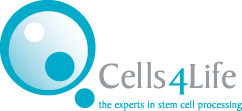Sickle Cell Anaemia and Stem Cells
Sickle cell disease is a severe form of anaemia. In sickle cell anaemia the red blood cells are deformed; rather than the usual disc shape they have a crescent or “sickle” shape, these sickle cells are also rigid as opposed to flexible like regular red blood cells. These sickle cells cause numerous problems for those with the condition; their shape means they do not flow around the body so easily and can even cause blockages which can result in severe pain and even organ damage for the sufferer. Sickle cells also die more quickly than healthy red blood cells resulting in anaemia as there are less effective red blood cells in the body to transport oxygen.[1]
Sickle cell anaemia is a genetic condition; for a baby to be born with sickle cell disease each parent must carry a copy of the disease. Each child they have will have a 25% chance of being unaffected, 50% chance of being a carrier of the sickle cell gene and 25% chance of having sickle cell disease.[2]
People of African, Caribbean, Middle Eastern, Eastern Mediterranean and Asian origin are most commonly affected by sickle cell disease. In the UK people of African and Caribbean heritage are most commonly affected.[1]
In 2013-14 the Department of Health spent an estimated £23.8 million on sickle cell anaemia, an increase of £2.1 million from 2012-13, these figures exclude primary and social care costs.[3]
Sickle Cell Anaemia Facts
- In the UK those with African and Caribbean heritage are most commonly affected[1]
- 250,000 people in the UK with sickle cell trait[1]
- Approximately 15,000 in the UK with sickle cell disease[4]
- 400,000 babies expected to be born with Sickle Cell Disease worldwide in 2050[5]
- Worldwide there was 305,800 newborns with sickle cell disease in 2010[5]
- In 2010 57% of newborns with sickle cell disease were from India, Democratic Republic of the Congo and Nigeria[5]
- Universal screening programs could save the lives of 10 million babies[5]
- Sickle cell disease is the most common inherited blood disorder in the UK[6]
- Life expectancy for sickle cell disease sufferers in high income countries is 40 – 60 years of age [7]
Sickle Cell Disease and Stem Cells
Children with sickle cell disease have successfully been treated with a stem cell transplant. Initially, this treatment was thought to be too toxic to be extended to adults with the disease after their bodies have been greatly weakened. However, researchers in Maryland have modified the transplant procedure to ascertain it’s potential in treating adults with sickle cell disease.
Between 2004 and 2013, 30 patients with severe sickle cell disease were enrolled in the trial. The patients, between the ages of 16 and 65, underwent a less toxic form of chemotherapy before they received stem cells donated by a healthy sibling.
The researchers discovered sickle cell disease was reversed in 87% of the patients. The patients had fewer hospital admissions; reduced drug use to treat the pain associated with sickle cell disease and had normal haemoglobin. A year after the transplant, 15 of the patients had stopped taking immunosuppressant medications.[8]
References
- http://www.nhs.uk/conditions/Sickle-cell-anaemia/Pages/Introduction.aspx
- http://sickle.bwh.harvard.edu/scd_inheritance.html
- http://www.parliament.uk/business/publications/written-questions-answers-statements/written-question/Commons/2014-12-01/216527/
- http://www.dmu.ac.uk/research/research-faculties-and-institutes/health-and-life-sciences/sickle-cell-education/what-is-sickle-cell.aspx
- http://www.medicinenet.com/script/main/art.asp?articlekey=171632
- www.pharmaceutical-journal.com
- http://patient.info/doctor/sickle-cell-disease-and-sickle-cell-anaemia-pro
- http://www.nih.gov/researchmatters/july2014/07142014sickle.htm
- The New England journal of medicine, 371(4), 339–348. https://doi.org/10.1056/NEJMsa1311707
- The New England journal of medicine, 386(7), 617–628. https://doi.org/10.1056/NEJMoa2117175
- Journal of clinical medicine, 11(16), 4775. https://doi.org/10.3390/jcm11164775
The information contained in this article is for information purposes only and is not intended to replace the advice of a medical expert. If you have any concerns about your health we urge you to discuss them with your doctor.




